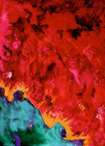 |
 |
Purgatory,
Canto XXV,
Verses 112-126 |
|
 |
More strictly illustrational in
tone are his other works connected with literary texts, which are nonetheless of very high
quality. Dated 1973-74 is the portfolio I cavalli innamorati, a group of 20
copperplates and color lithographs, in which a theme typical of his art provides a
functional counterpoint to a selection of poems by Raffaele Carrieri. In 1974 he also illustrated Ariosto's Orlando Furioso in 15 colored
engravings, with an introduction by Vittorio Sereni; the title of the portfolio is Fantasie
d'amore e di guerra dell'Orlando furioso. Sassu utilizes yet another technique,
watercolor, to narrate in 58 panels the story of I Promessi sposi, by Alessandor
Manzoni, collected in a book printed in 1892 in 1,999 copies.
Mention should also be made of the etching and six
lithographs printed in 100 copies for Apocalisse, a volume published also in 1982;
the lithographs contained in the portfolio Quattro studi per il Decamerone, of
1983; and seven color lithographs on the theme of Don Quixote, of 1985, printed in 125
copies. Finally, 1989 saw the publication of Omero: gli Inni, in which Homer's text
is accompanied by 5 lithographs, with a press run of 155 copies, and in 1991 appeared
Sophocles L'Edipo Re, six watercolors in 90 copies. |

